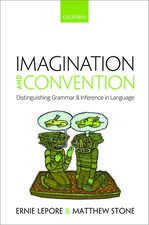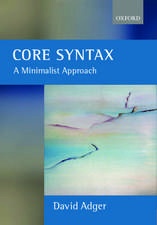Phrase Structure in Natural Language: Studies in Natural Language and Linguistic Theory, cartea 21
Autor M.J. Speasen Limba Engleză Hardback – 30 sep 1990
| Toate formatele și edițiile | Preț | Express |
|---|---|---|
| Paperback (1) | 641.71 lei 6-8 săpt. | |
| SPRINGER NETHERLANDS – 30 sep 1990 | 641.71 lei 6-8 săpt. | |
| Hardback (1) | 648.05 lei 6-8 săpt. | |
| SPRINGER NETHERLANDS – 30 sep 1990 | 648.05 lei 6-8 săpt. |
Din seria Studies in Natural Language and Linguistic Theory
- 24%
 Preț: 808.06 lei
Preț: 808.06 lei - 18%
 Preț: 788.72 lei
Preț: 788.72 lei - 18%
 Preț: 958.56 lei
Preț: 958.56 lei - 15%
 Preț: 600.26 lei
Preț: 600.26 lei - 18%
 Preț: 947.67 lei
Preț: 947.67 lei - 15%
 Preț: 646.62 lei
Preț: 646.62 lei - 18%
 Preț: 723.56 lei
Preț: 723.56 lei - 15%
 Preț: 604.84 lei
Preț: 604.84 lei - 18%
 Preț: 952.09 lei
Preț: 952.09 lei - 15%
 Preț: 642.51 lei
Preț: 642.51 lei - 18%
 Preț: 947.50 lei
Preț: 947.50 lei - 15%
 Preț: 646.75 lei
Preț: 646.75 lei - 18%
 Preț: 1224.54 lei
Preț: 1224.54 lei - 15%
 Preț: 641.71 lei
Preț: 641.71 lei - 18%
 Preț: 2314.56 lei
Preț: 2314.56 lei - 18%
 Preț: 952.89 lei
Preț: 952.89 lei - 18%
 Preț: 1220.12 lei
Preț: 1220.12 lei - 15%
 Preț: 642.83 lei
Preț: 642.83 lei - 18%
 Preț: 944.19 lei
Preț: 944.19 lei - 18%
 Preț: 952.57 lei
Preț: 952.57 lei - 18%
 Preț: 1729.61 lei
Preț: 1729.61 lei - 15%
 Preț: 644.95 lei
Preț: 644.95 lei - 15%
 Preț: 644.63 lei
Preț: 644.63 lei -
 Preț: 384.48 lei
Preț: 384.48 lei - 18%
 Preț: 1662.85 lei
Preț: 1662.85 lei - 18%
 Preț: 955.08 lei
Preț: 955.08 lei - 18%
 Preț: 952.40 lei
Preț: 952.40 lei -
 Preț: 386.81 lei
Preț: 386.81 lei
Preț: 648.05 lei
Preț vechi: 762.42 lei
-15% Nou
Puncte Express: 972
Preț estimativ în valută:
124.02€ • 129.00$ • 102.39£
124.02€ • 129.00$ • 102.39£
Carte tipărită la comandă
Livrare economică 14-28 aprilie
Preluare comenzi: 021 569.72.76
Specificații
ISBN-13: 9780792307556
ISBN-10: 0792307550
Pagini: 308
Ilustrații: XII, 308 p.
Dimensiuni: 156 x 234 x 19 mm
Greutate: 0.63 kg
Ediția:1990
Editura: SPRINGER NETHERLANDS
Colecția Springer
Seria Studies in Natural Language and Linguistic Theory
Locul publicării:Dordrecht, Netherlands
ISBN-10: 0792307550
Pagini: 308
Ilustrații: XII, 308 p.
Dimensiuni: 156 x 234 x 19 mm
Greutate: 0.63 kg
Ediția:1990
Editura: SPRINGER NETHERLANDS
Colecția Springer
Seria Studies in Natural Language and Linguistic Theory
Locul publicării:Dordrecht, Netherlands
Public țintă
ResearchCuprins
1: Modularity in Underlying Structure.- 1.1 Introduction.- 1.2 On Defining Grammatical Relations in a Modular Theory.- 1.3 What is a Lexical Entry?.- 1.4 The Organization of Argument Structure: the Thematic Hierarchy.- 1.5 Case Theory and the Lexicon.- 1.6 S and S?: Extended X-bar Theory and the Lexical Clause Hypothesis.- 1.7 Dominance, Precedence and Phrase Markers.- Notes.- 2: Syntactic Projection and Licensing.- 2.1 Preliminaries: Licensing, the UTAH, the Projection Principle and the Theta Criterion.- 2.2 X-bar Theory and the Projection of Heads.- 2.3 Licensing Non-head Daughters: Thematic Grids and Thematic Relations.- 2.4 Functional Categories and Licensing.- 2.5 Summary.- Notes.- 3: On Configurationality Parameters.- 3.1 Introduction.- 3.2 Parametric Variation in D-Structure Principles.- 3.3 What is a Nonconfigurational Language?.- 3.4 The Empirical Evidence for D-Structure Variation.- 3.5 Summary and Conclusions.- Notes.- 4: Projection, Pronouns, and Parsing in Navajo Syntax.- 4.1 Introduction.- 4.2 An Overview of Navajo Syntax and Morphology.- 4.3 Parsing, Null Arguments, and Grammatical Relations in Navajo.- 4.4 On Navajo Nominals as Adjuncts.- 4.5 Navajo Agreement and Incorporated Pronouns.- 4.6 Conclusion: Projection from the Lexicon in Navajo.- Notes.- 5: Concluding Remarks.- References.- Index of Names.- Index of Subjects.
Recenzii
`Her book deserves a reading by anyone interested in questions of phrase structure.'
Language, 69
`Speas' book is a unique and comprehensive presentation of how syntactic structure is projected from lexical items, and how the syntactic diversity of the world's languages might consequently be seen from a unified perspective. Highly readable in its overview of the theoretical backgroud, and in its account of new developments and their consequences, this is a valuable and stimulating textbook for any course in syntactic structure and typological variation.'
Kenneth L. Hale, MIT, Cambridge, USA
Language, 69
`Speas' book is a unique and comprehensive presentation of how syntactic structure is projected from lexical items, and how the syntactic diversity of the world's languages might consequently be seen from a unified perspective. Highly readable in its overview of the theoretical backgroud, and in its account of new developments and their consequences, this is a valuable and stimulating textbook for any course in syntactic structure and typological variation.'
Kenneth L. Hale, MIT, Cambridge, USA












